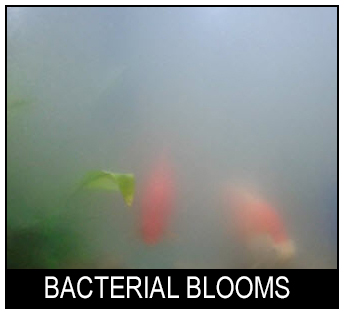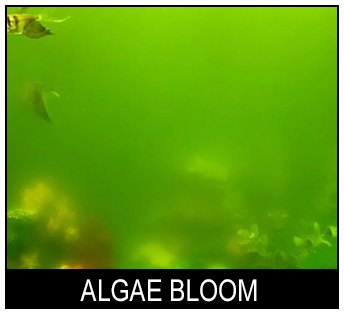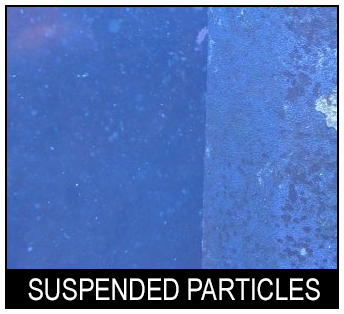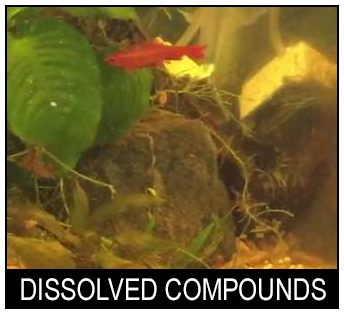Why Is MyAquarium Cloudy?
(A Guide to Crystal Clear Water)
There are a variety of reasons your aquarium water can be cloudy but they all come down to 4 primary causes:
- Bacterial Blooms
- Algae Blooms
- Suspended Particles
- Dissolved Compounds
Once you know what is causing your cloudy water you can know what steps to take to get your water clear again.
BACTERIAL BLOOMS
What are bacterial blooms?

Bacterial blooms are caused by an overabundance of bacteria in the aquarium water column. Bacterial blooms usually look like a milky white cloud in your tank. If the bloom is severe you may even see white slimy strings of bacteria on the surfaces of the glass or aquarium hardscape.
What causes bacterial blooms?
Bacterial blooms happen when there is a sudden increase in the amount of nutrients in the water. The bacteria grow quickly in order to eat and break down the excess nutrients. Usually, these nutrients are in the form of ammonia and nitrite. While the bacterial bloom is ugly it is a sign of a deeper problem. High ammonia and nitrite can kill fish and other aquatic animals.
What to do about bacterial blooms?
If you think you have a bacterial bloom start by testing your water for
ammonia and
nitrite. There should be no detectable ammonia and nitrite in an established aquarium. If your tank is new then a bacterial bloom is normal and should pass in a couple of days to a week. Your aquarium is establishing a healthy bacterial population that will help keep your aquarium water clean and clear in the long run. If your aquarium is more than a month old, and already established, then if you see ammonia and nitrite perform a partial water change as soon as possible to get the levels down and help save your fish. Ammonia and nitrite are highly toxic to fish. Once the levels are under control, try to identify what caused them to rise. A dead fish, overfeeding, or a malfunctioning filter can all cause excess nutrients that can cause a bacterial bloom.
What if it keeps happening?
If you have continual bacterial blooms then you are likely overfeeding or under-filtering your aquarium. You will need to either reduce the amount of fish food you are feeding or increase filtration to compensate. Adding a
UV sterilizer will stop bacterial blooms by killing the bacteria in the water, but it will not stop the underlying problem of toxic ammonia and nitrite in the water. Before you purchase a UV sterilizer first make sure that you have ammonia and nitrite levels under control.
Further Reading:
-
UV Sterilizer Overview
-
Aquarium Testing Recommendations
ALGAE BLOOMS
What is an algae bloom?

Algae blooms are when there is a sudden increase in free-floating algae. This typically looks like cloudy green aquarium water. This is also very common in outdoor ponds. If you have seen a pond with green-tinted water, you have seen an algae bloom.
What causes algae blooms?
Algae blooms are caused by a combination of light and nutrients. Just like with bacterial blooms an abundance of nutrients can lead to an algae bloom. What often causes an algae bloom rather than a bacterial bloom is the amount of light. If there is low light and a sudden influx of nutrients then a bacterial bloom is likely, but if the aquarium is brightly lit then an algae bloom is more likely. Algae blooms can also happen if there is a sudden increase in light levels. This can happen when you leave your aquarium light on overnight, let the sun shine on the tank all day, or switch to a more powerful light.
What to do about Algae Blooms?
Start by testing your aquarium water for a
mmonia and
nitrite. If either of these levels is high then immediately perform a partial water change as the aquarium water is unsafe for fish. After the water change, try to identify what caused the nutrients to spike. It could be a dead fish, overfeeding, or a malfunctioning filter. If you test the water and there is no detectable ammonia and nitrite, then excess light is likely the cause of the algae bloom. Make sure that your lights are only on for 8-12 hours per day. Keep the aquarium out of direct sunlight and if the aquarium has dimmable lights turn down the power to lower the light levels. In some cases, you will not be able to lower the light levels, such as if the aquarium is in a brightly lit room, next to windows without window coverings, or if the tank is outdoors. In these cases, adding a
UV sterilizer is the best option. The UV sterilizer will kill the algae in the water column and keep the tank clear.
What if it keeps happening?
If you have continual algae blooms then adding a
UV sterilizer is the best option. UV sterilizers are nearly a necessity for ponds and outdoor aquariums because of the access light.
Further Reading:
-
UV Sterilizer Overview
-
Aquarium Testing Recommendations
SUSPENDED PARTICLES
What are suspended particles?

Suspended particles are simply small solids that are floating around in the aquarium water. They can come from uneaten fish food, aquarium substrate, fish poop, fish and invertebrate spawning, and many other things.
What causes suspended particles?
There will always be some suspended particles in the aquarium water. Some particles can be beneficial such as fish food or plankton. However, they can get out of hand and ruin the viewing experience. Some common causes of excessive particles include, freshly added aquarium gravel, burrowing fish or animals that knock sand into the air, and spawning fish or invertebrates.
What to do about suspended particles?
The best way to remove particles from the aquarium water is with mechanical filtration. The finer the mechanical filtration the smaller the particles it can remove. The gold standard for mechanical filtration is a 25-micron filter. 25 microns is the smallest particle size the human eye can see so these filters will remove anything that you could see as a particle while not being so fine that they quickly clog. If your tank is cloudy from a temporary event such as adding new sand, using a polishing filter such as the
Marineland Magnum Polishing Internal Canister Filter or
Marineland Magnum 200 Polishing Internal Canister Filter will allow you to temporarily add an affordable polishing filter to the tank to quickly clear up the water. You can remove the filter once the water is clear these filters use 25-micron cartridges and will remove any particles you can see.
What if the particles keep coming back?
If you constantly have particles in the water it may be best to add a permanent polishing filter. The best option is the
Inland Seas Nu-Clear Model 533 Mechanical Canister Filter, 25 Micron Cartridge. This is a canister filter that uses a very large 25-micron cartridge to polish the water. Use the
1533 Extension for extra-large aquariums.
NuClear Canister Filters are very popular in small commercial aquariums where crystal-clear water is very important for viewing but these filters can also be used for home aquariums. For more information see our
Nu-Clear Canister Filter Overview video.
DISSOLVED COMPOUNDS
What are dissolved compounds?

If you have seen a glass of tea, you will notice that the tea has a dark tint to it yet there are no particles in the tea. All of the tea leaves added to the water are fully dissolved. Aquarium water can also have dissolved compounds that come from organic sources such as fish foods, fish waste, driftwood, and plants. These compounds are fully dissolved and no amount of mechanical filtration will effectively remove them from the water. Dissolved compounds often appear as a slight brown tint to the aquarium water. Often you may only notice the tint against a white background or when looking through the short side of the aquarium through the length of the aquarium to the other side.
What causes dissolved compounds?
Dissolved compounds come from fish foods, fish waste, plant waste, driftwood, coral excretions, and many other sources. If you are noticing a sudden increase in dissolved compounds then some common causes are new fish foods or new driftwood. Dissolved compounds build up over time. In aquariums that do not receive regular water changes, there may be a significant brown tint to the water.
What to do about dissolved compounds?
The simplest way to remove dissolved compounds from your water is with filtration carbon.
Inland Seas Activated Carbon is our favorite because it is low in dust and easy to use in most filters. Simply add some carbon to a media bag rinse the carbon of dust and then add the carbon bag to a high-flow area of the aquarium such as a canister filter, sump, or hang-on filter. The carbon will absorb the dissolved compounds and clarify the water. In most cases, you will notice a water quality improvement within 24 hours. Carbon can only absorb so much before it loses its effectiveness. The vast majority of filtration carbonís usefulness is within the first week of use.
What if the dissolved compounds keep coming back?
It is normal for dissolved compounds to slowly accumulate in aquariums. Because of this, we recommend replacing filtration carbon on a monthly basis. This will keep the dissolved compound levels low and lead to clearer better-looking water.




























 Bacterial blooms are caused by an overabundance of bacteria in the aquarium water column. Bacterial blooms usually look like a milky white cloud in your tank. If the bloom is severe you may even see white slimy strings of bacteria on the surfaces of the glass or aquarium hardscape.
Bacterial blooms are caused by an overabundance of bacteria in the aquarium water column. Bacterial blooms usually look like a milky white cloud in your tank. If the bloom is severe you may even see white slimy strings of bacteria on the surfaces of the glass or aquarium hardscape. Algae blooms are when there is a sudden increase in free-floating algae. This typically looks like cloudy green aquarium water. This is also very common in outdoor ponds. If you have seen a pond with green-tinted water, you have seen an algae bloom.
Algae blooms are when there is a sudden increase in free-floating algae. This typically looks like cloudy green aquarium water. This is also very common in outdoor ponds. If you have seen a pond with green-tinted water, you have seen an algae bloom. Suspended particles are simply small solids that are floating around in the aquarium water. They can come from uneaten fish food, aquarium substrate, fish poop, fish and invertebrate spawning, and many other things.
Suspended particles are simply small solids that are floating around in the aquarium water. They can come from uneaten fish food, aquarium substrate, fish poop, fish and invertebrate spawning, and many other things. If you have seen a glass of tea, you will notice that the tea has a dark tint to it yet there are no particles in the tea. All of the tea leaves added to the water are fully dissolved. Aquarium water can also have dissolved compounds that come from organic sources such as fish foods, fish waste, driftwood, and plants. These compounds are fully dissolved and no amount of mechanical filtration will effectively remove them from the water. Dissolved compounds often appear as a slight brown tint to the aquarium water. Often you may only notice the tint against a white background or when looking through the short side of the aquarium through the length of the aquarium to the other side.
If you have seen a glass of tea, you will notice that the tea has a dark tint to it yet there are no particles in the tea. All of the tea leaves added to the water are fully dissolved. Aquarium water can also have dissolved compounds that come from organic sources such as fish foods, fish waste, driftwood, and plants. These compounds are fully dissolved and no amount of mechanical filtration will effectively remove them from the water. Dissolved compounds often appear as a slight brown tint to the aquarium water. Often you may only notice the tint against a white background or when looking through the short side of the aquarium through the length of the aquarium to the other side.